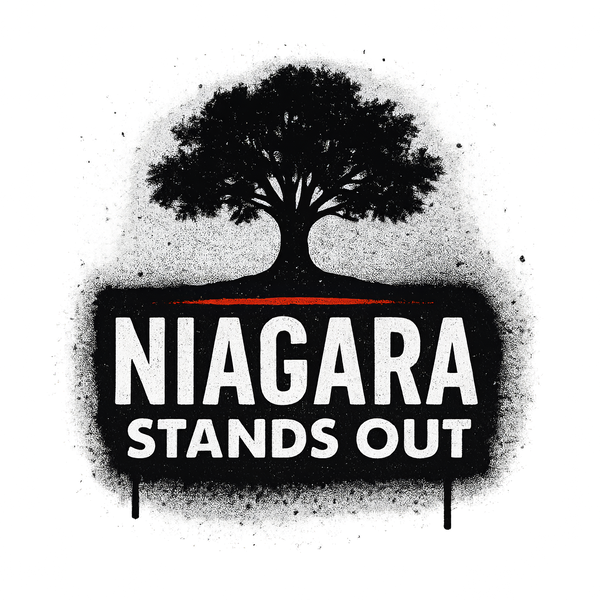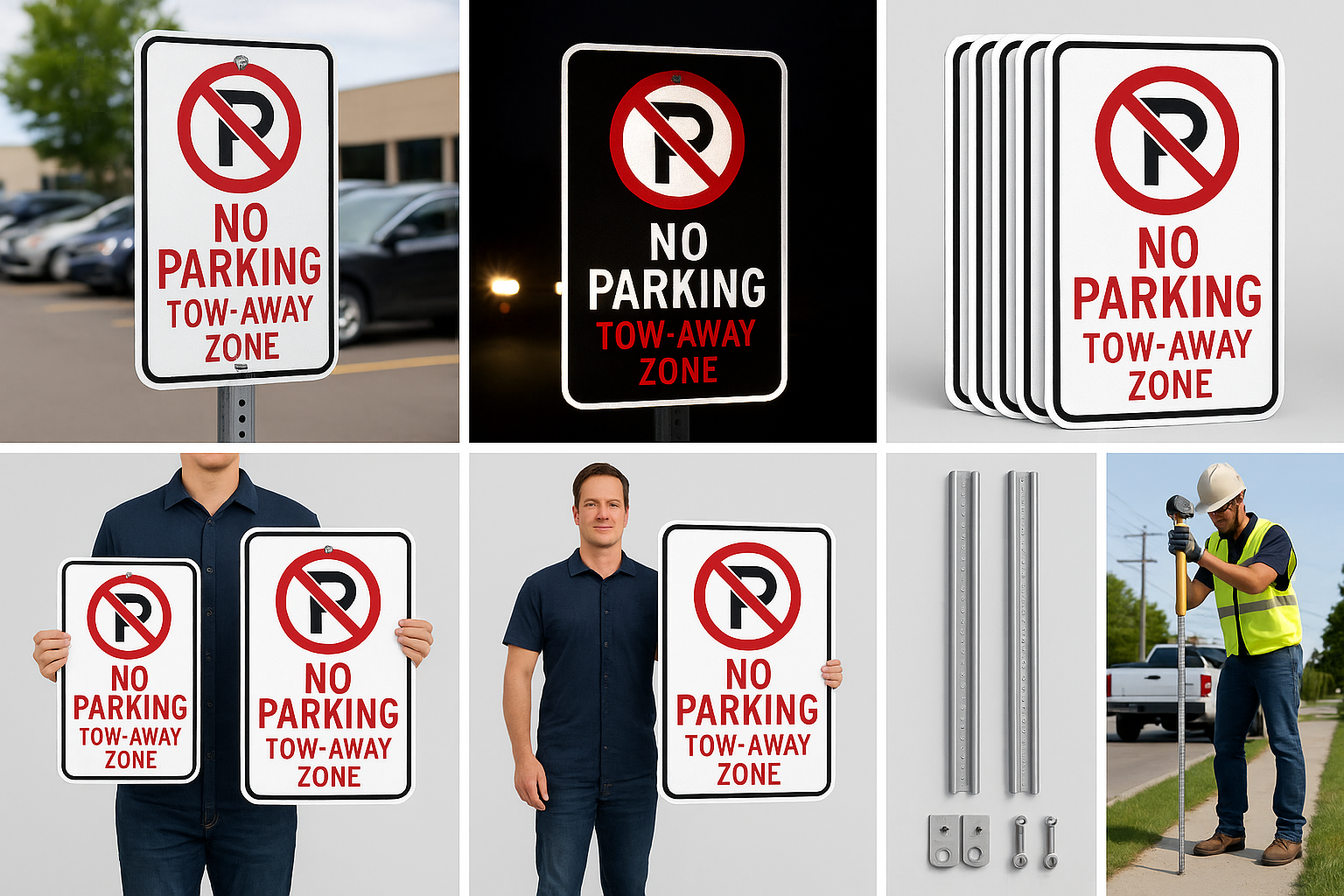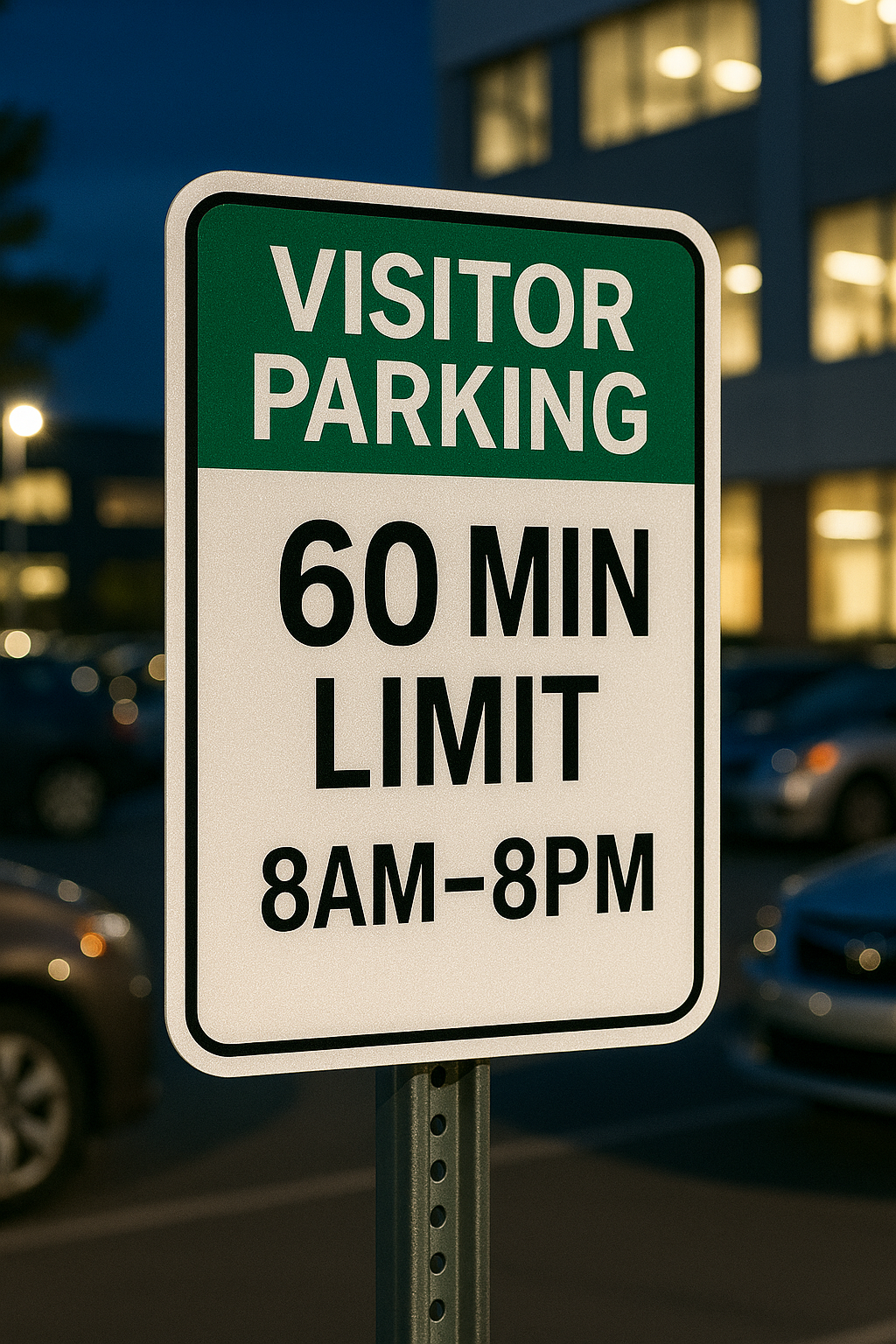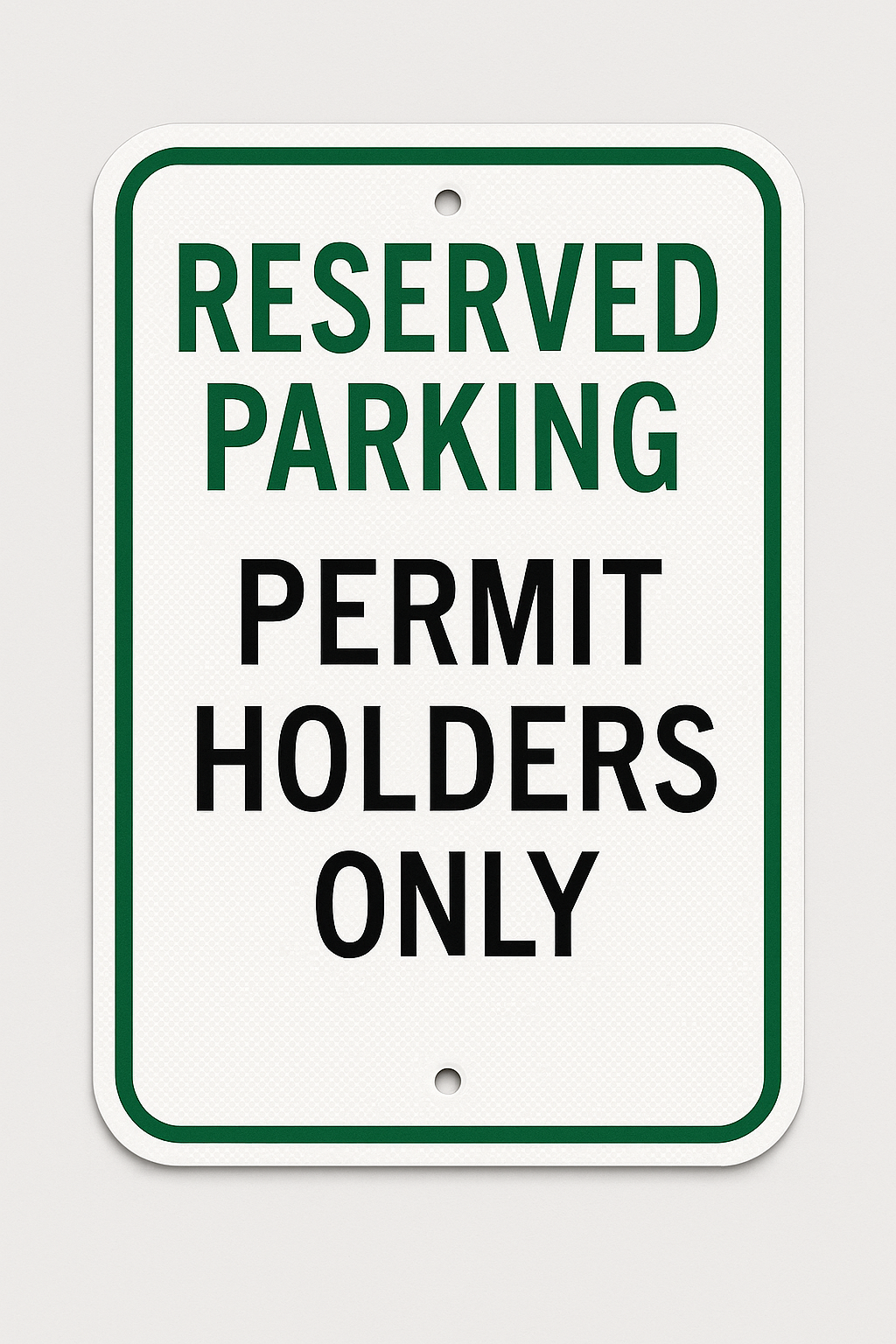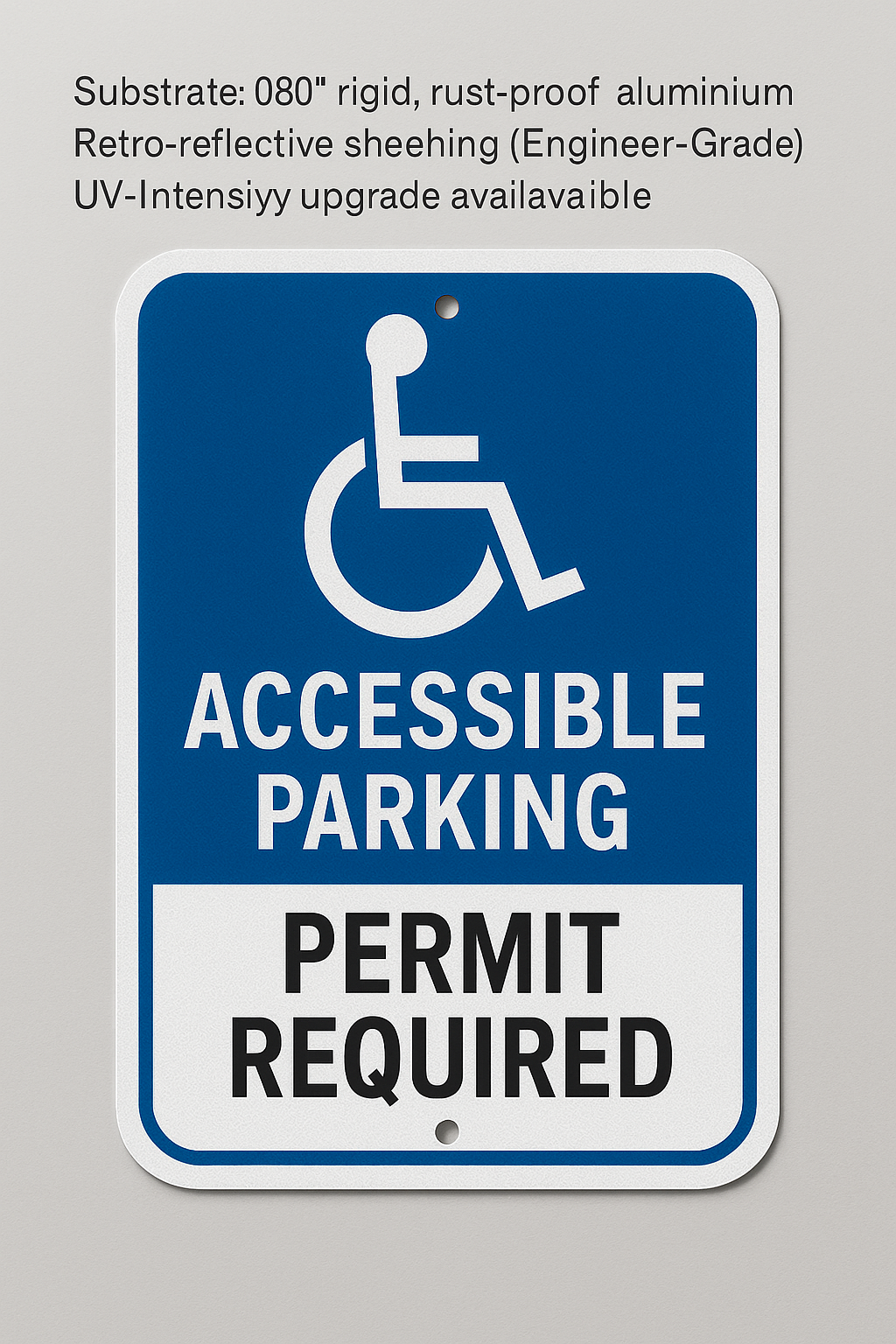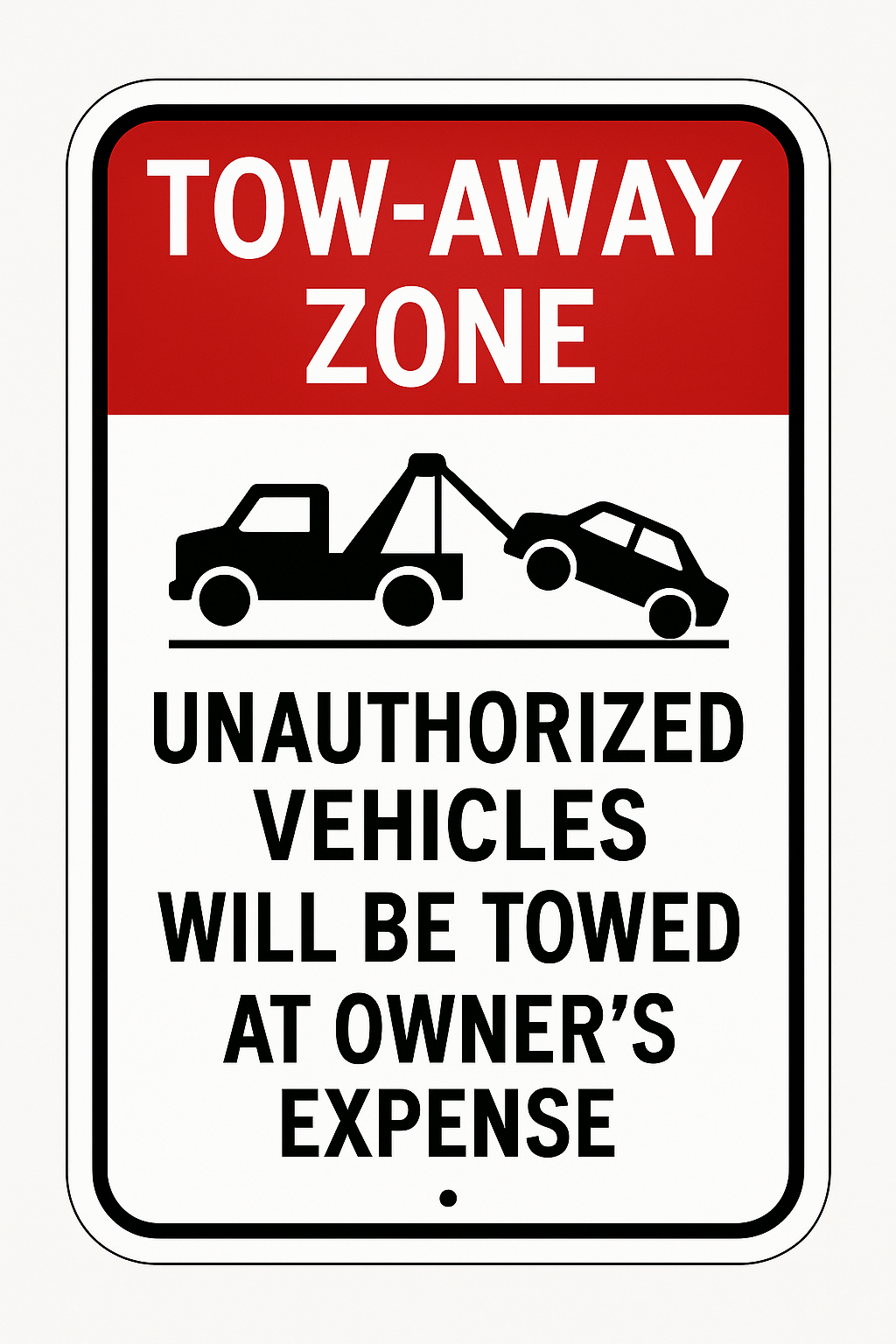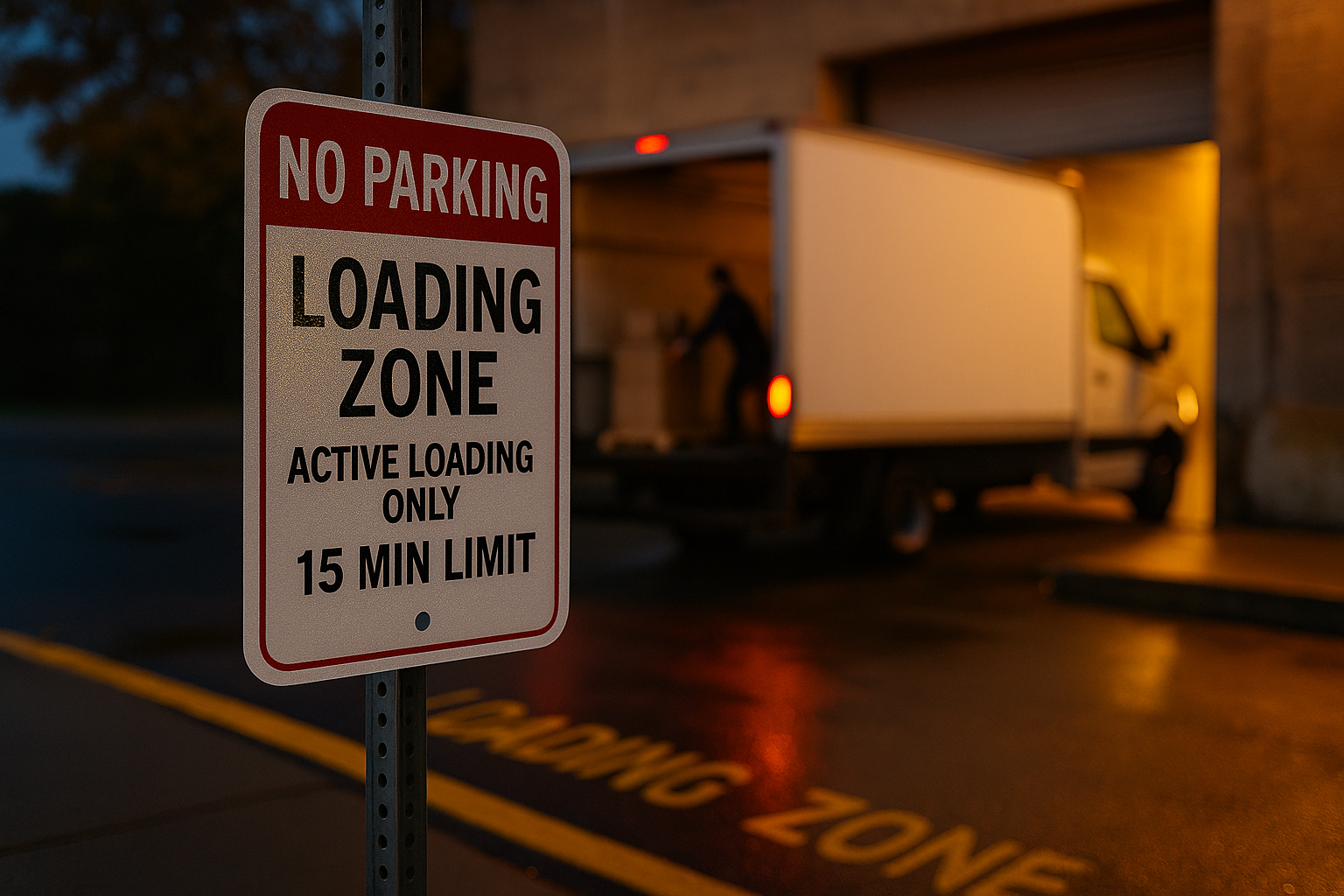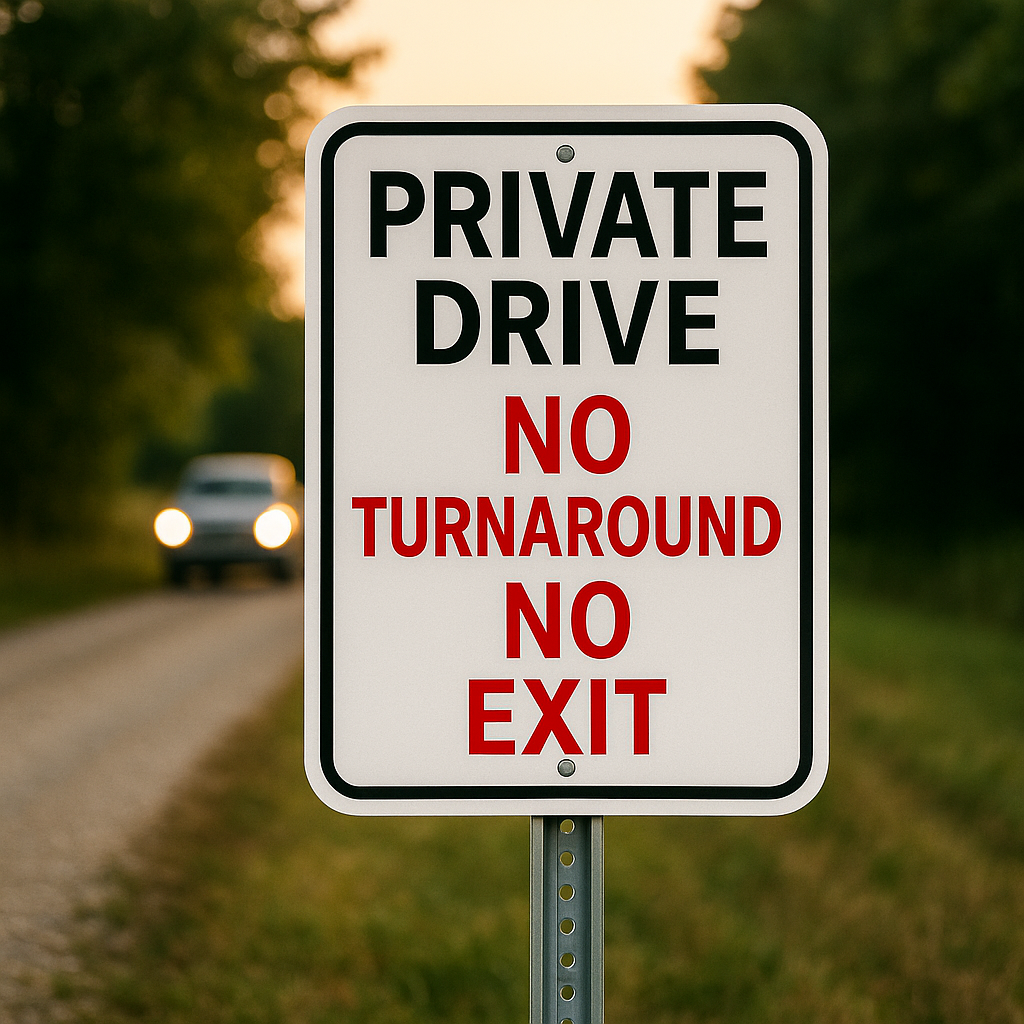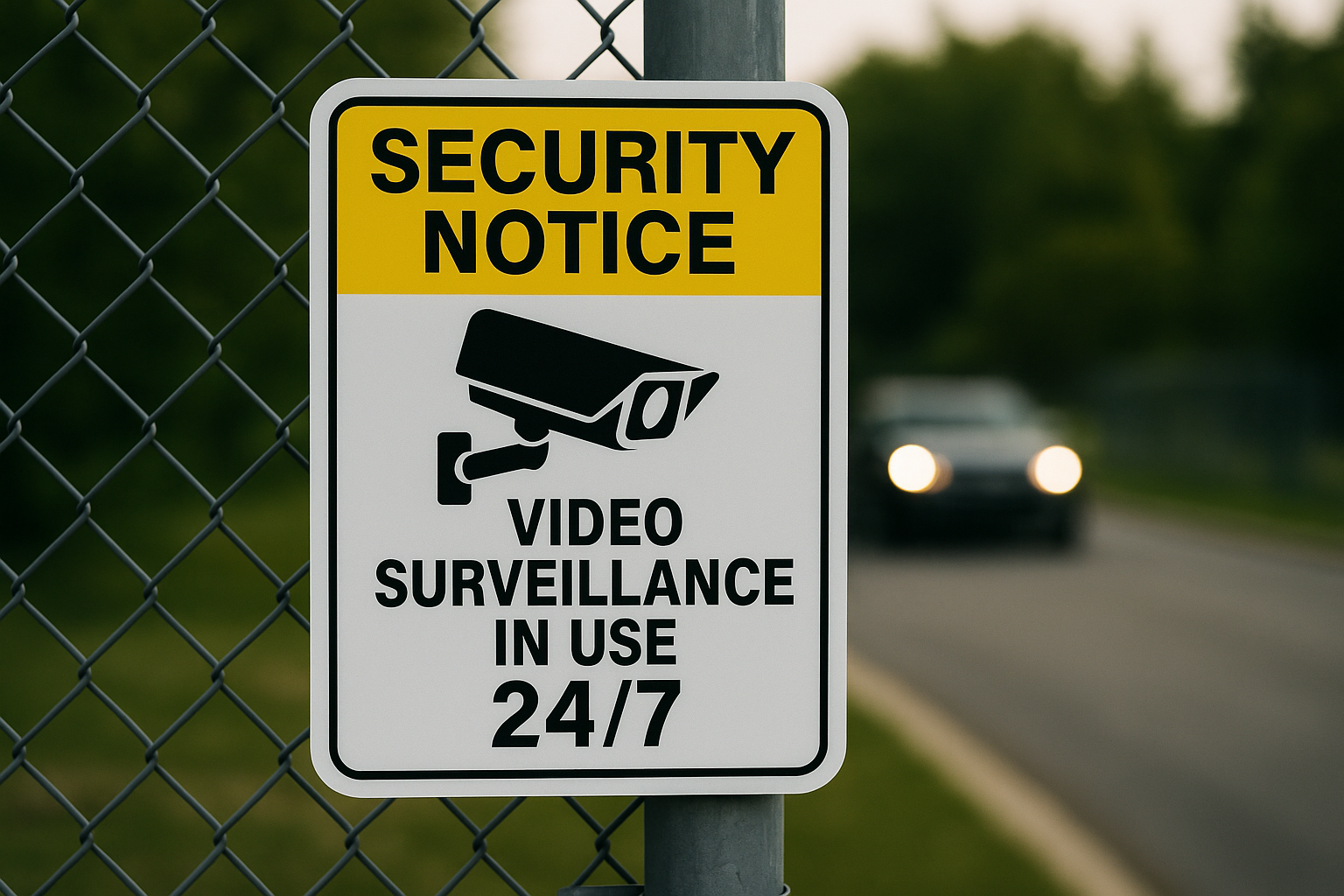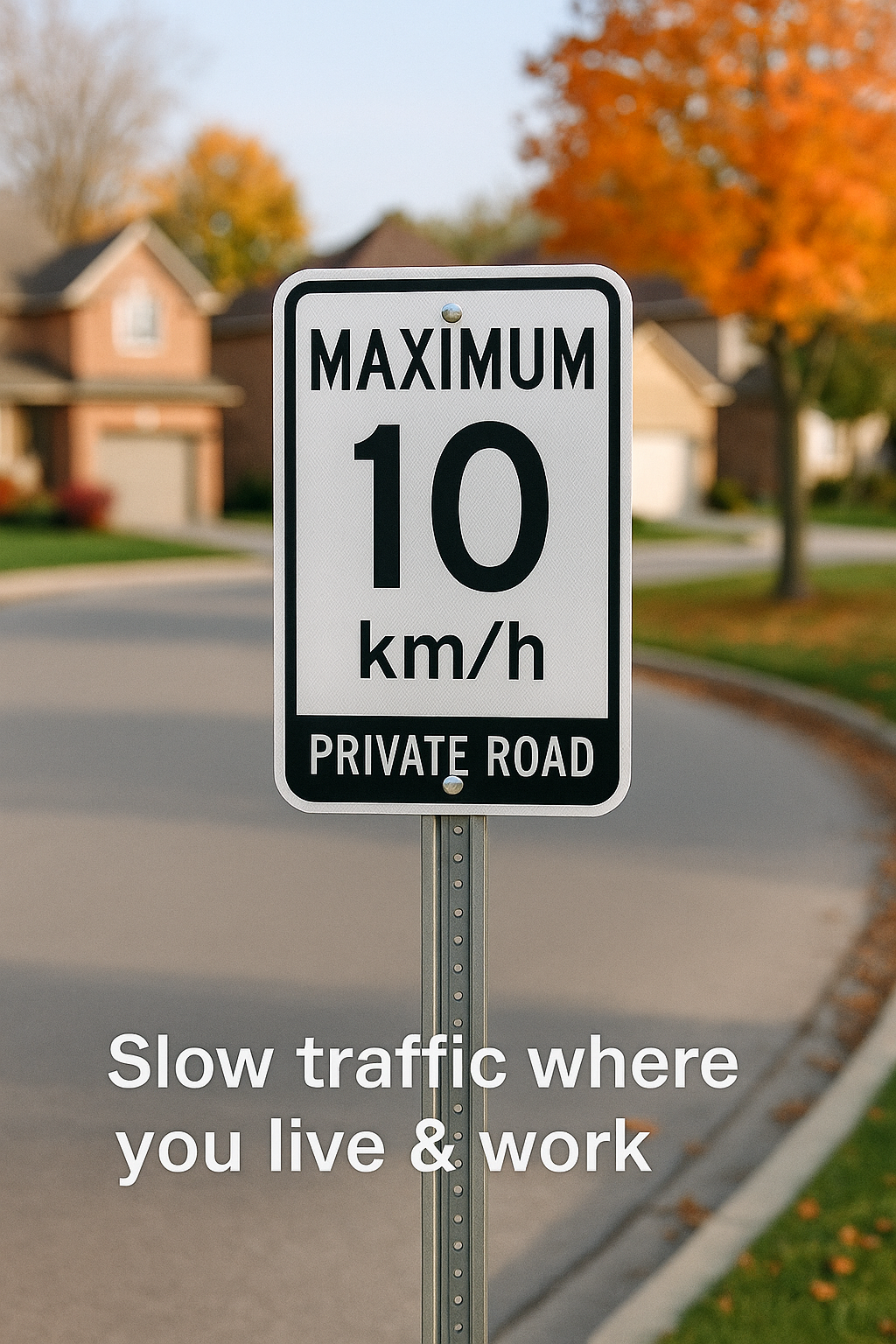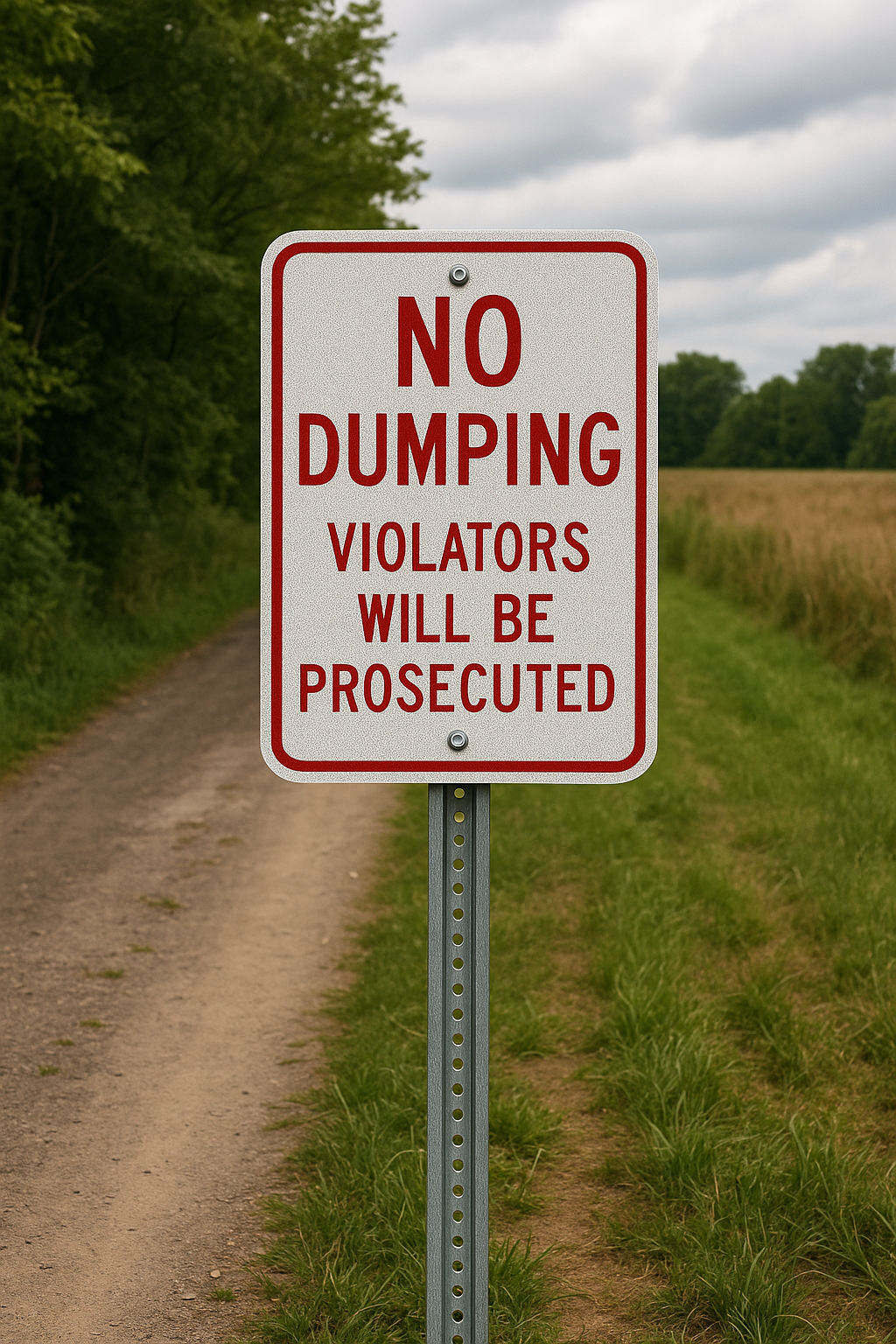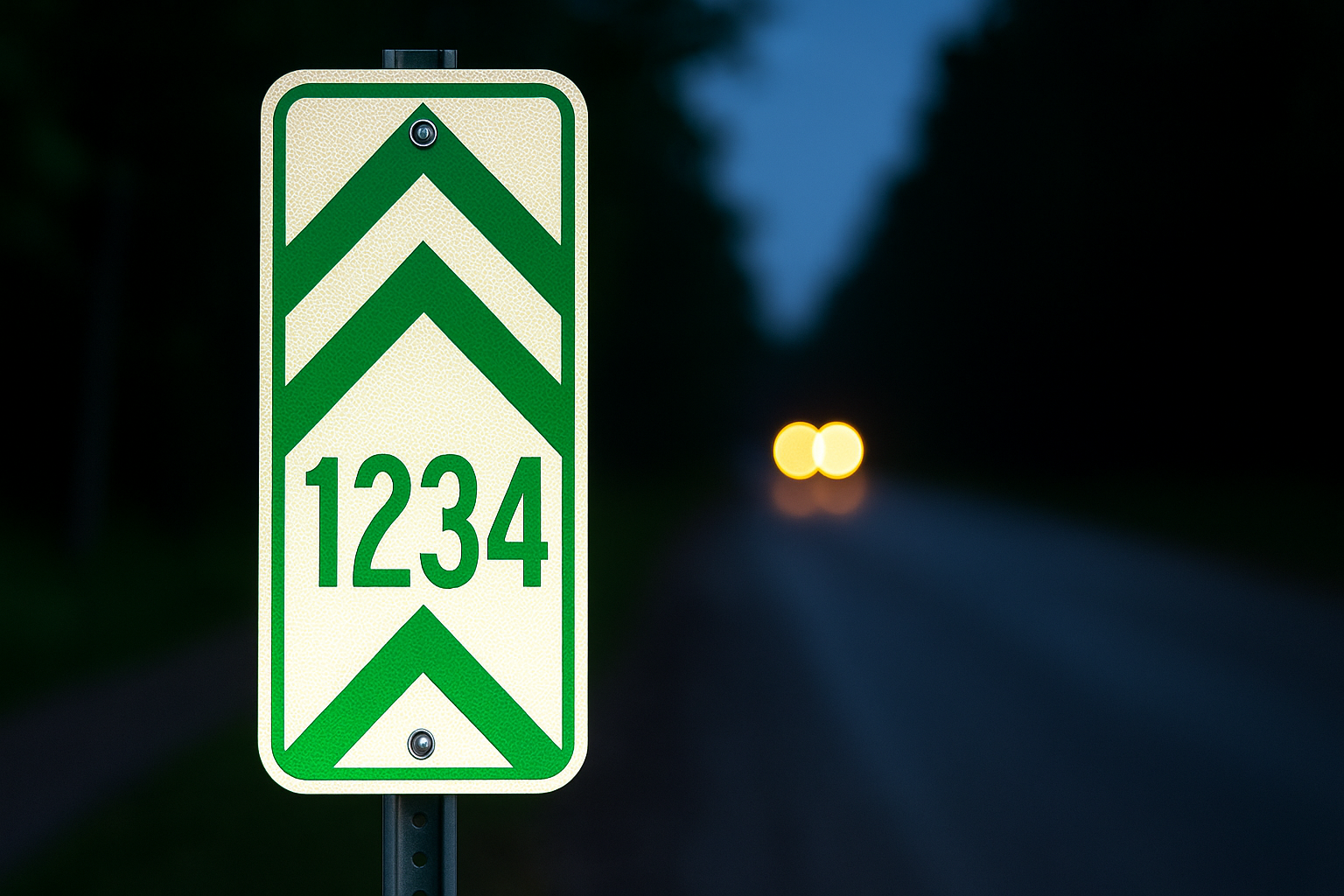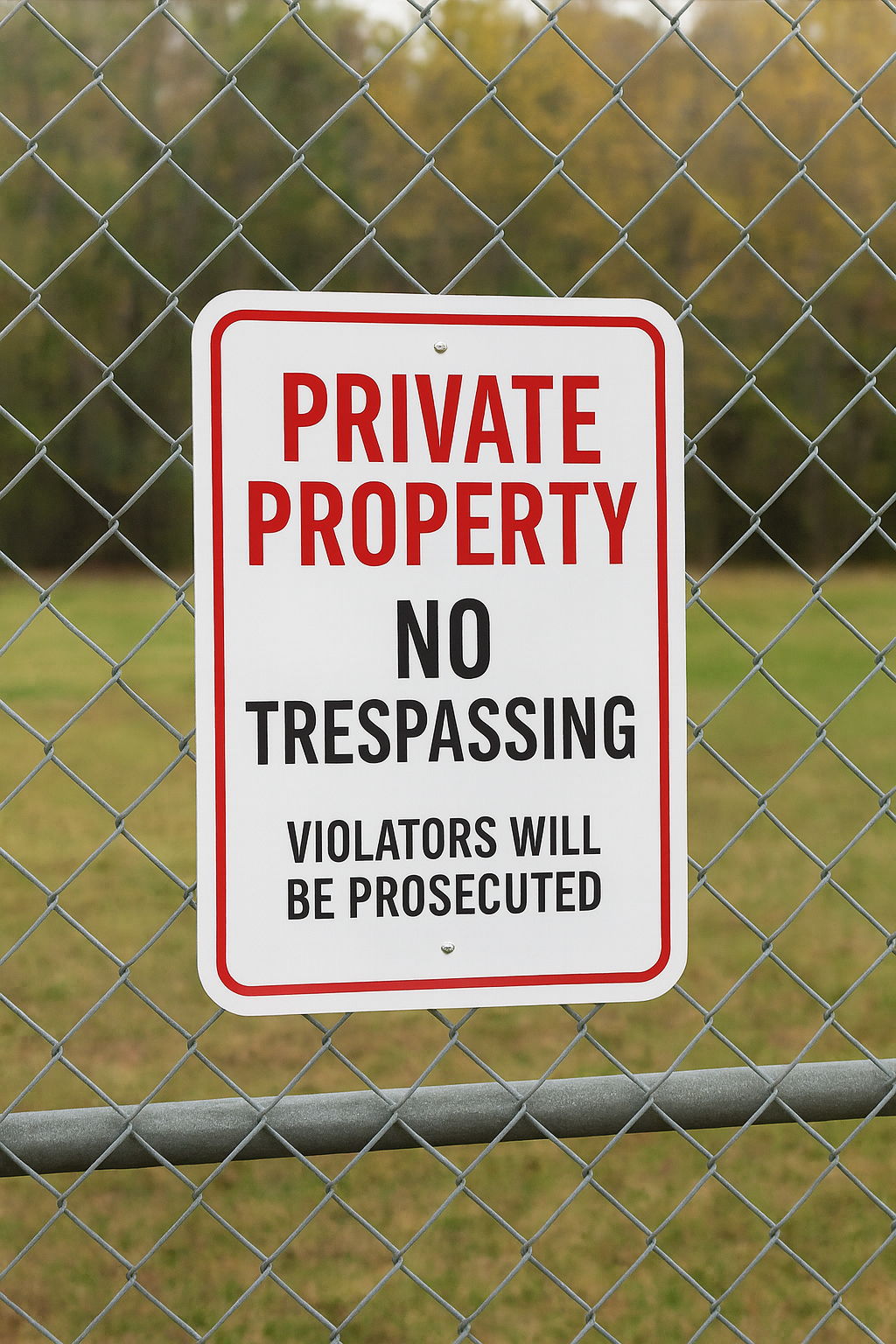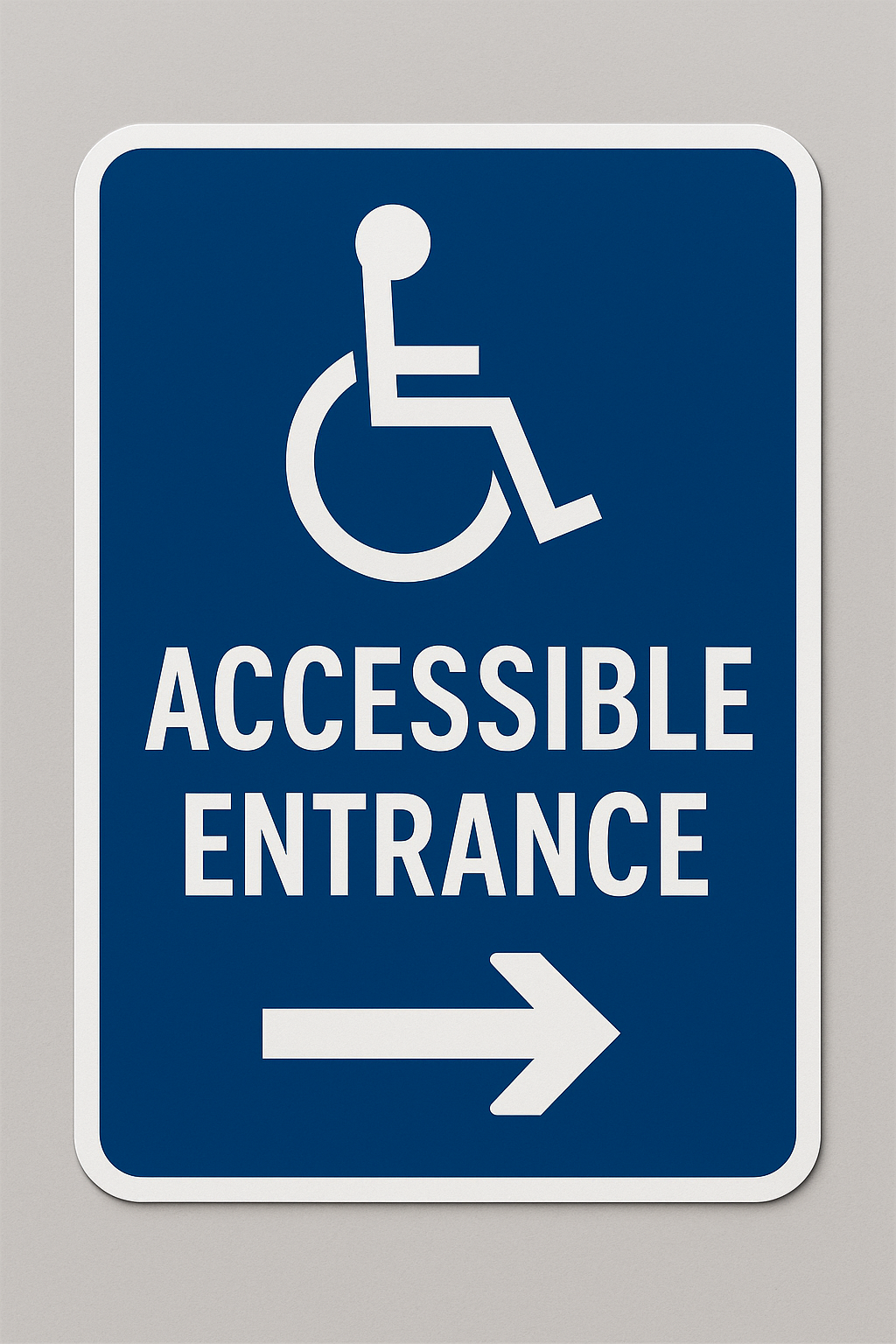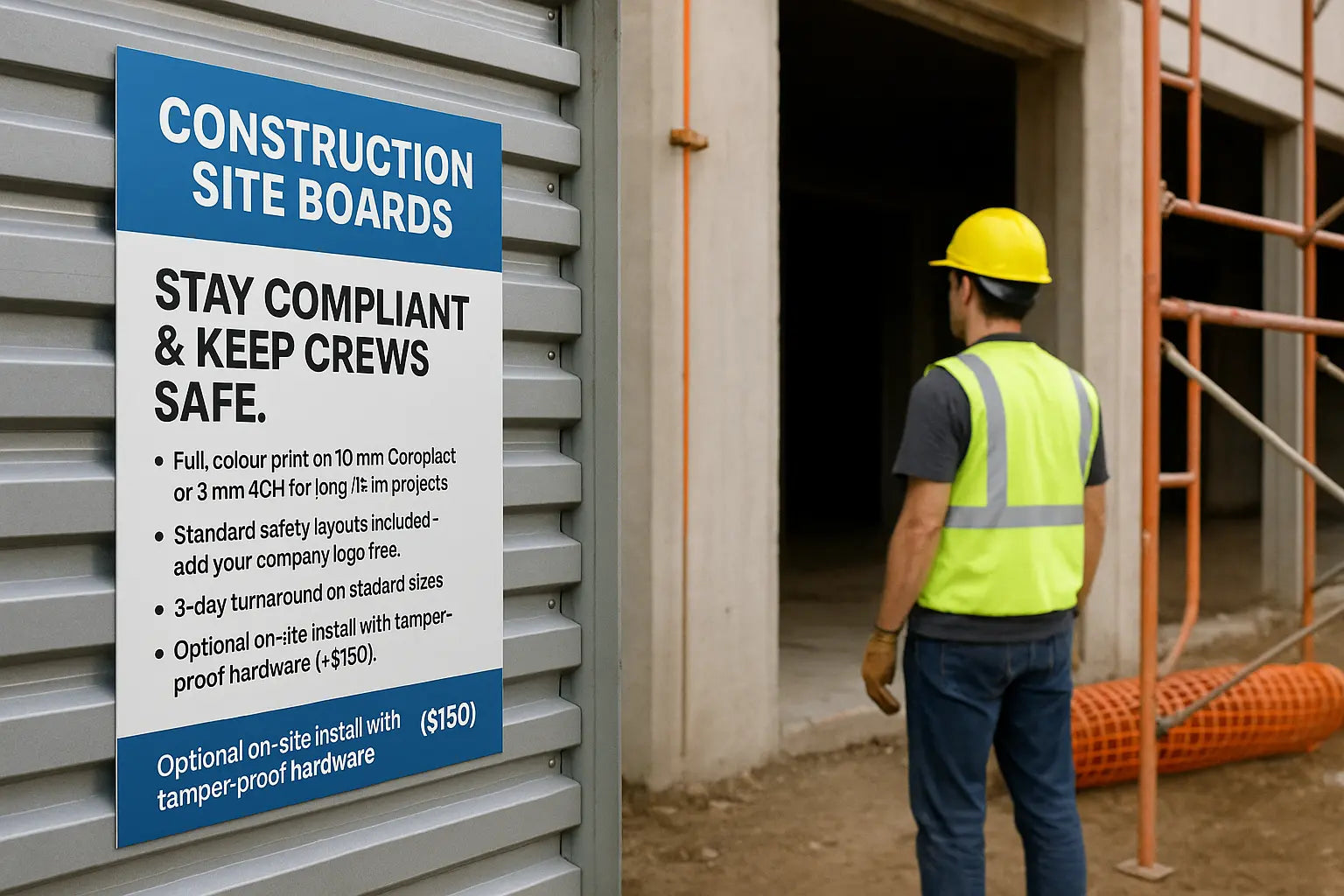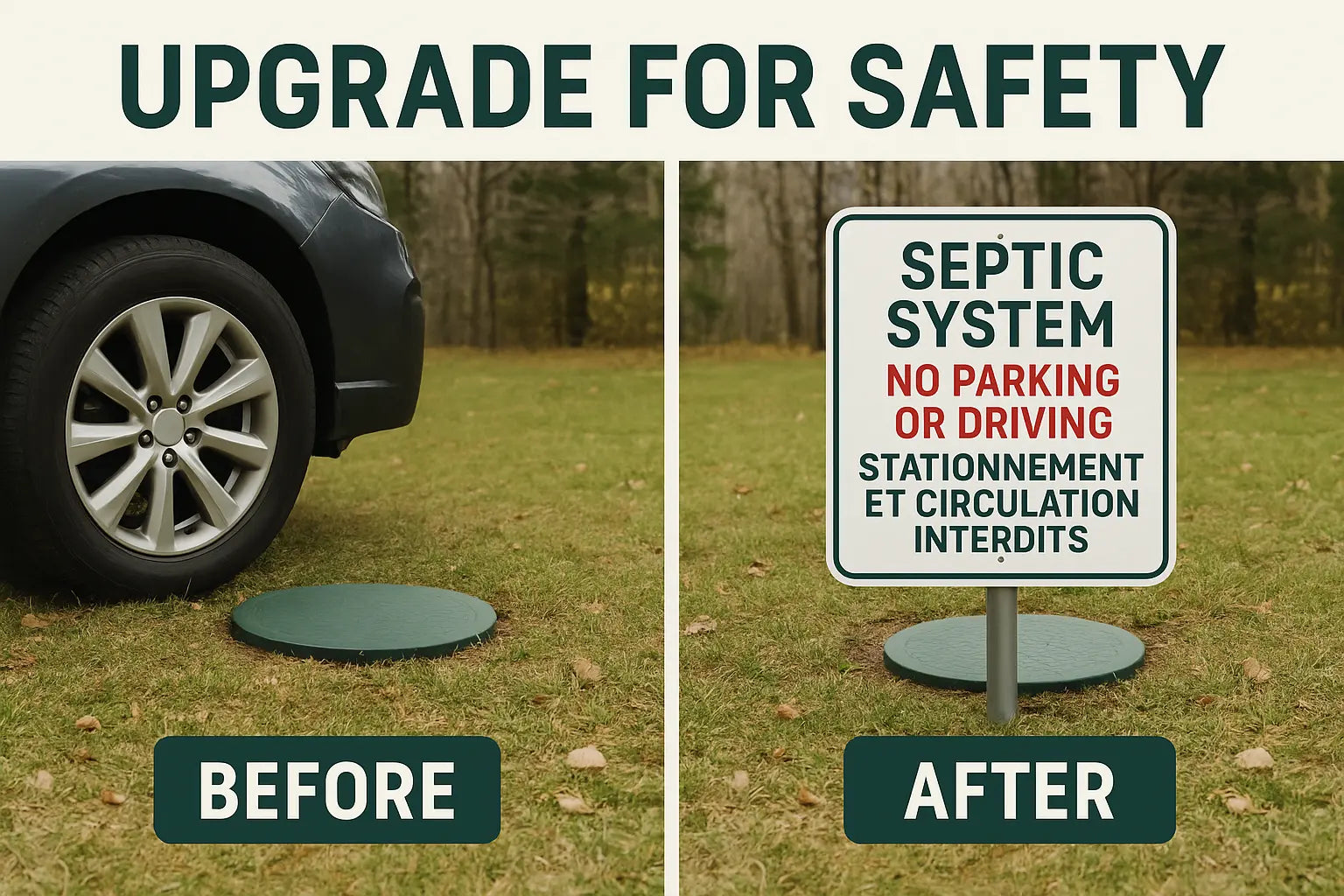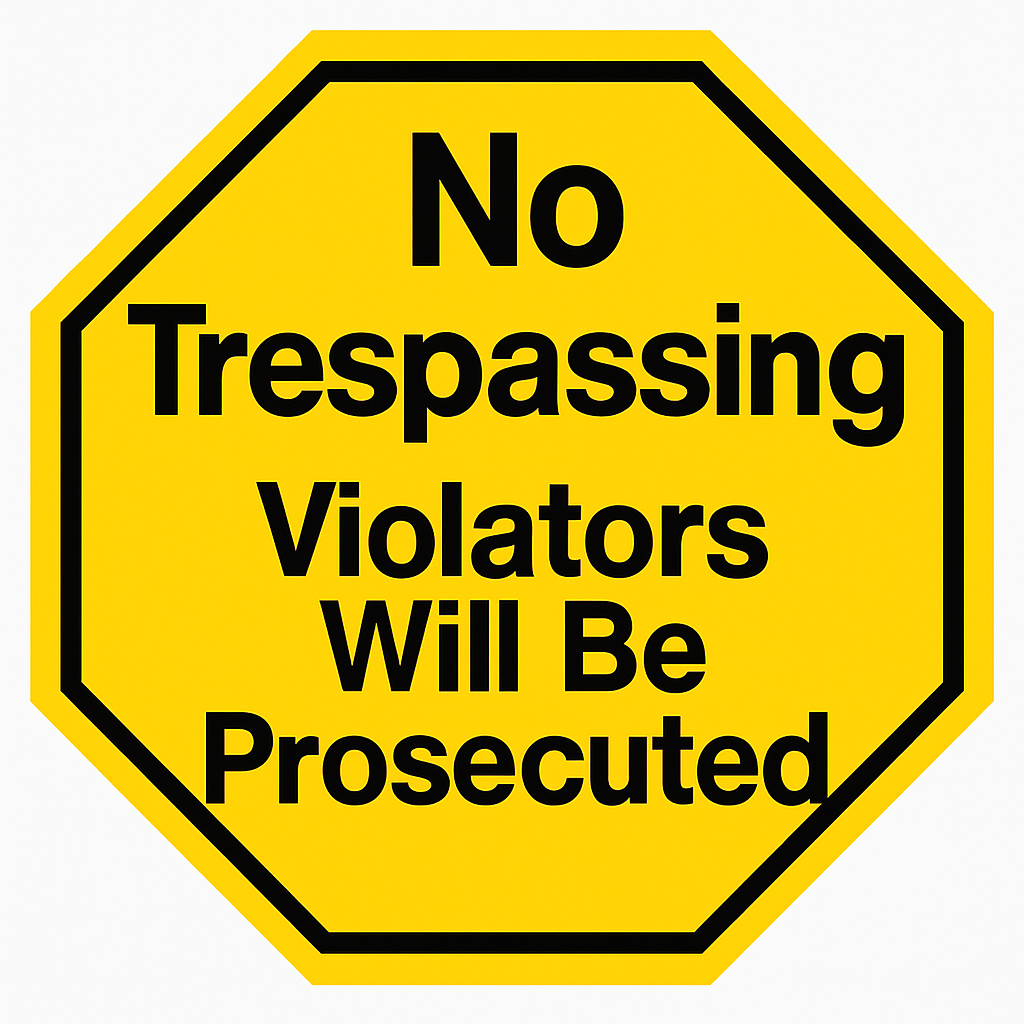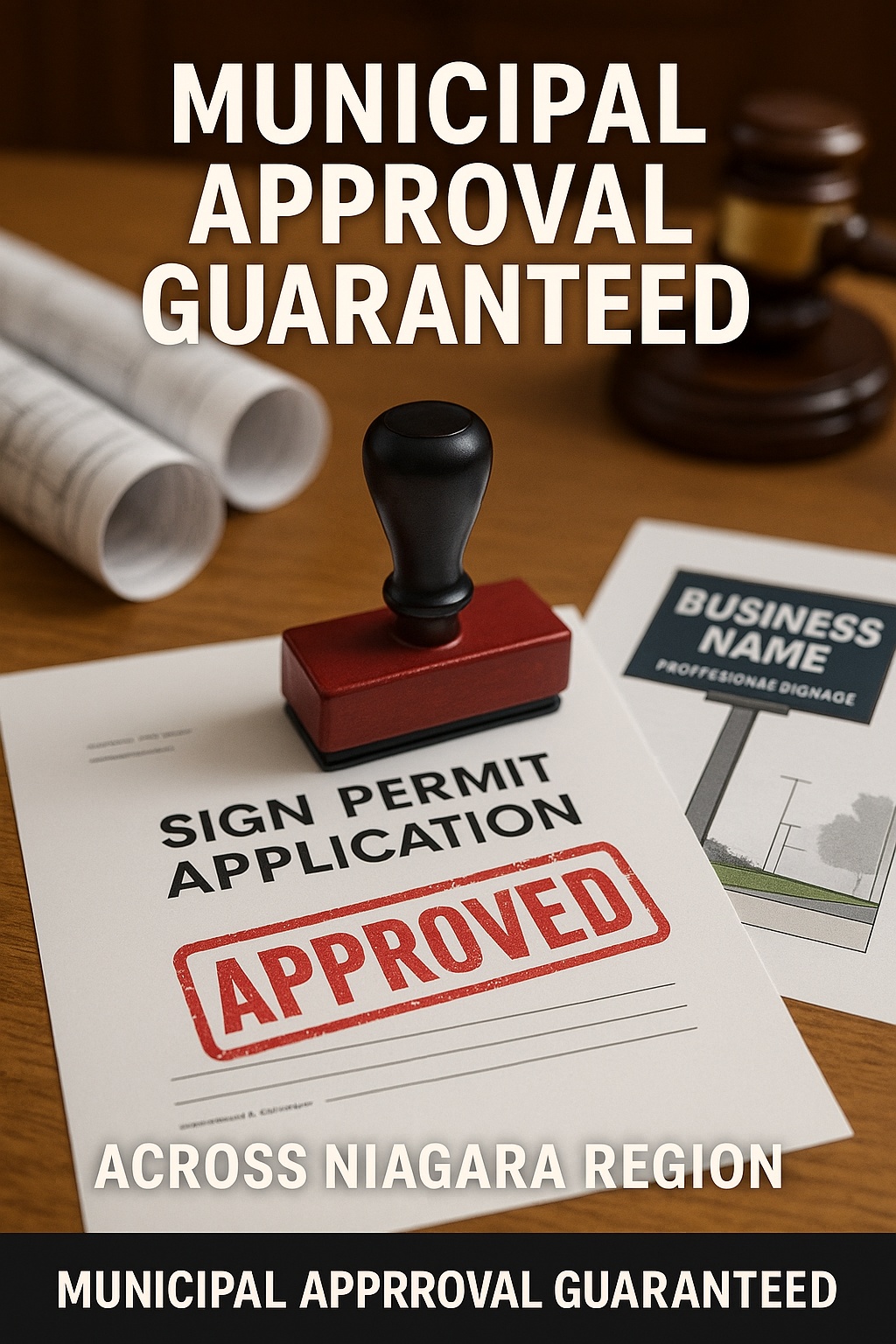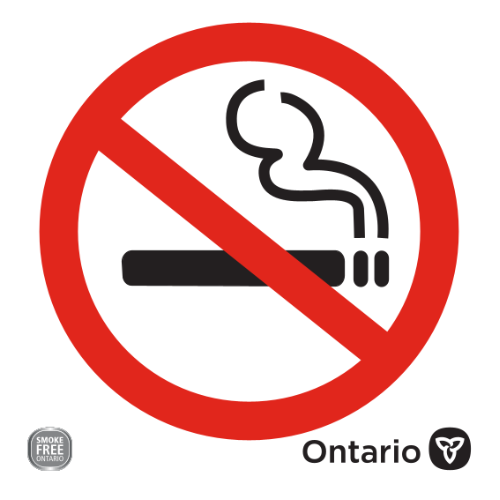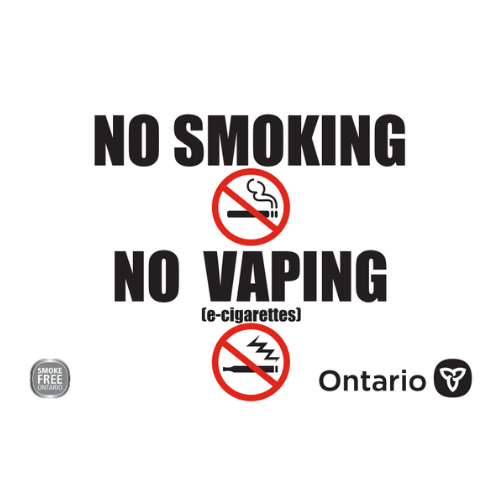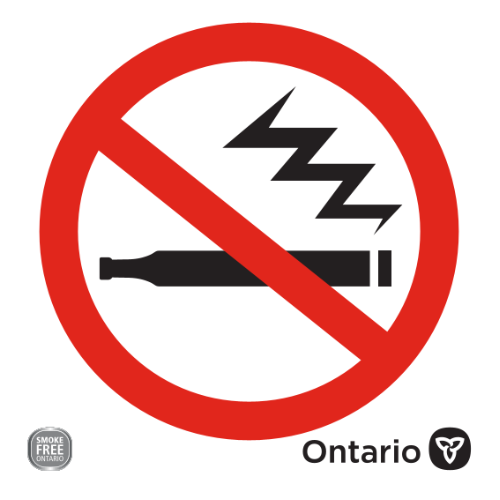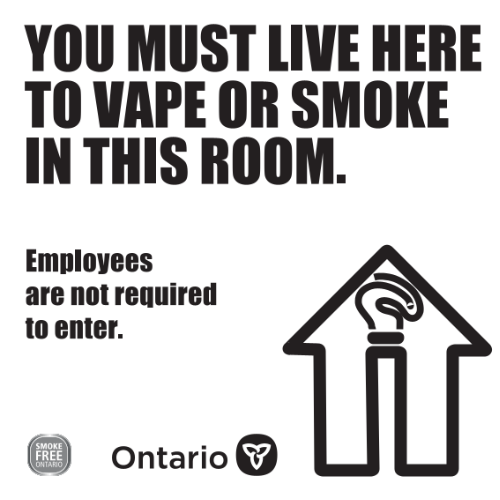Parking & Safety Signs Installation | Niagara Compliance
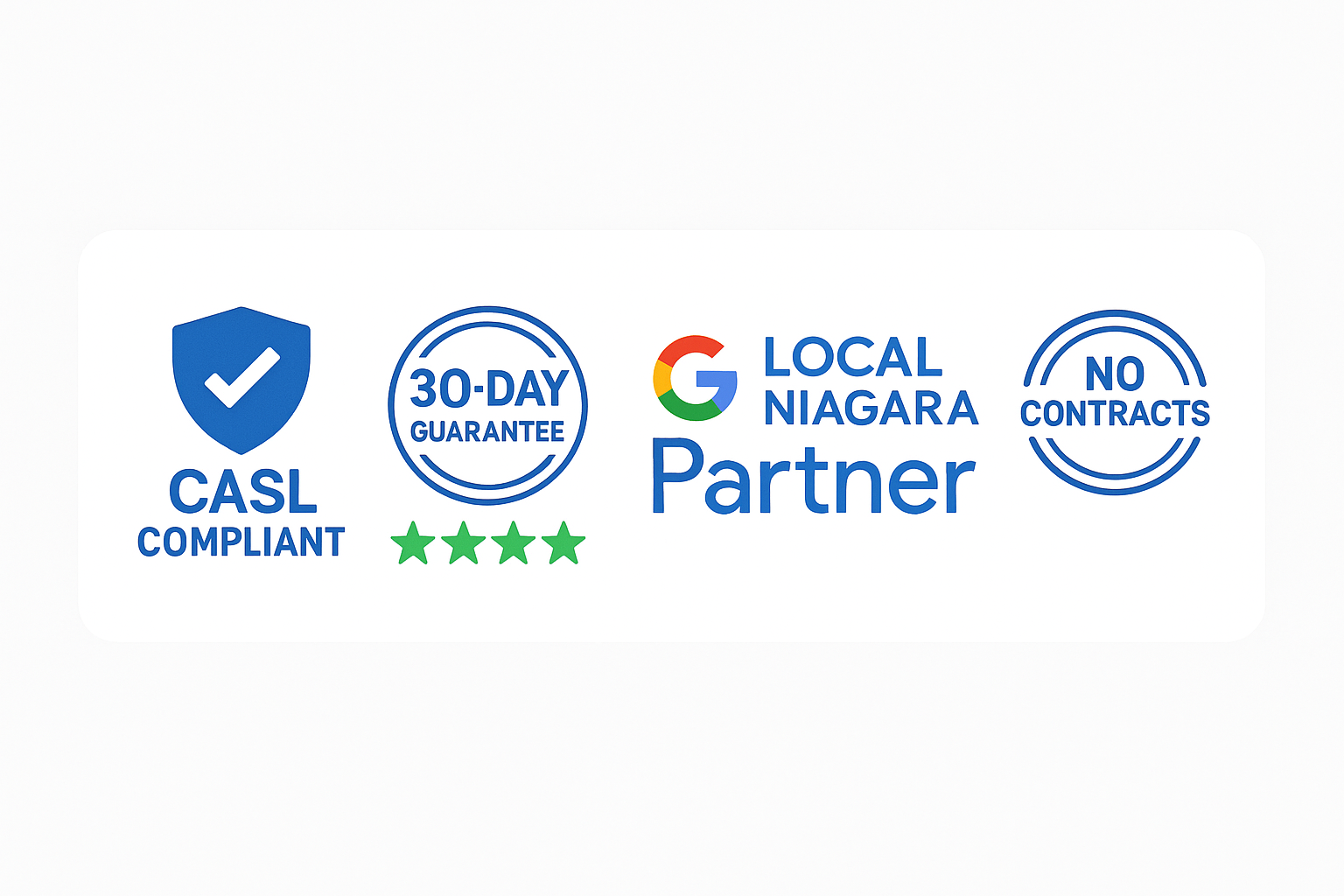
-
No Parking / Tow‑Away Zone Signs (Niagara) | Service Packages -
Visitor Parking — Time Limited (Niagara) -
Reserved Parking — Permit Holders Only (Niagara) -
Accessible Parking — Permit Required (Ontario ISA) | Same Day Niagara -
Tow-Away Zone — Unauthorized Vehicles Will Be Towed (Niagara) -
Loading Zone — No Parking (Niagara) -
Private Drive — No Turnaround / No Exit (Niagara) -
Security Notice — Video Surveillance In Use (24/7) (Niagara) -
Speed Limit — 10 / 15 km/h (Private Road) (Niagara) -
No Dumping — Violators Will Be Prosecuted (Niagara) -
Unit / Lot Number & Private Lane Address Markers (Niagara) -
Private Property / No Trespassing Signs – Niagara -
Accessible Parking Signs – Niagara Region (On... | Same Day Niagara -
Professional Parking Control Suite - Private Lot Signs & Enforcement | Niagara -
Construction Site Safety Signs – Coroplast or ACM (Niagara) -
Cottage Septic & Well Safety Signs | Bilingual & Weatherproof | Made in Canada -
No Trespassing Decal Canada | Legal Property Warning Sticker -
Permit-Ready Business Signs Niagara | Municipal Approvals Guaranteed | Heritage District Specialists -
Warehouse Floor Safety Pack -
Niagara Region SFOA 2017 Compliant No Smoking No Vaping Signs | St Catharines Welland Fort Erie Business Signage | Official Ontario Compliance Packs
Parking & Safety Signs Niagara: OHSA Compliant Workplace Signs, Municipal Parking Compliance, Property Management Signage
Niagara Region businesses, property managers, and facility operators maintain safety compliance and parking regulations with professional signage designed for Ontario requirements. From fire route signs meeting Ontario Fire Code standards to OHSA-compliant workplace safety signs, proper signage protects your business from liability, prevents Ministry of Labour violations, ensures municipal bylaw compliance, and creates safe environments for employees, tenants, and visitors across St. Catharines, Niagara Falls, Welland, Fort Erie, and all 12 Niagara municipalities.
Parking signs regulate vehicle traffic, designate reserved spaces, identify accessible parking, and warn against unauthorized parking on private property. Safety signs communicate hazards, indicate emergency equipment locations, require personal protective equipment, and guide emergency evacuations in workplaces. Both categories carry legal requirements—missing or inadequate signage results in municipal fines, Ministry of Labour orders, insurance claim denials, and potential liability in injury lawsuits.
Our Niagara parking and safety sign collections use weather-resistant aluminum with reflective coatings rated for -40°C to +80°C, ensuring 5-10+ year outdoor durability through Ontario winters, summer heat, road salt exposure, and UV fading. Pre-designed templates expedite production (3-5 business days), while custom signs accommodate property-specific needs, bilingual EN/FR requirements, and unique workplace hazards. Installation services, post kits, and compliance consultation available for Niagara properties and facilities.
Why Compliant Signage Matters for Niagara Businesses
Proper signage isn't just best practice—it's legally mandated for Ontario businesses, property managers, and facility operators. Non-compliance carries financial penalties, operational disruptions, and legal liability that far exceed signage costs.
Regulatory compliance: Ontario Fire Code requires fire route signs meeting specific size, color, spacing, and placement standards. Accessible parking requires AODA-compliant signs with International Symbol of Access, permit requirements, and penalty information. OHSA mandates workplace safety signs for hazardous areas, emergency equipment, PPE requirements, and evacuation routes. Municipal parking bylaws in St. Catharines, Niagara Falls, Welland, and Fort Erie specify signage requirements for commercial properties, multi-unit residential buildings, and public-access parking lots.
Liability protection: Proper signage demonstrates due diligence in premises liability lawsuits. If someone is injured in an area lacking proper warning signs (wet floor, overhead hazard, confined space), property owners face negligence claims. Courts evaluate whether reasonable safety measures were implemented—adequate signage is foundational evidence of responsible property management. Insurance companies may deny claims if required safety signage was absent.
Ministry of Labour enforcement: OHSA inspectors conduct proactive workplace inspections across Niagara's manufacturing, construction, warehousing, and industrial sectors. Missing safety signs trigger compliance orders requiring immediate correction, potential stop-work orders, and escalating fines for repeat violations. Corporate penalties reach $1,500,000 per violation. Individual supervisors and directors face personal liability. Workplace fatalities with safety deficiencies can result in criminal prosecution under Bill C-45 (Westray Law).
Municipal fines and enforcement: Parking bylaws carry enforcement teeth. Properties lacking required fire route signs face fire marshal orders and potential occupancy permit revocation. Accessible parking violations incur $300-5,000 fines per space. Private property towing requires specific signage—unauthorized towing without proper warning signs exposes property owners to legal challenges from vehicle owners.
Operational efficiency: Clear parking signage reduces confusion, prevents unauthorized parking, guides visitors to correct areas, and minimizes disputes between tenants, employees, and visitors. Safety signs reduce workplace injuries by increasing hazard awareness, reminding workers of PPE requirements, and indicating emergency equipment locations. Proactive signage is more cost-effective than addressing preventable injuries, parking disputes, or regulatory violations after they occur.
Parking Signs for Niagara Region Properties
Property managers, commercial landlords, multi-unit residential buildings, retail centers, healthcare facilities, and industrial parks require parking signage for traffic control, accessibility compliance, fire safety, and private property enforcement.
Fire route signs: Ontario Fire Code Section 2.5.4.1 requires fire route signs along emergency vehicle access routes. Fire routes must remain clear for fire department apparatus—parked vehicles block emergency response and endanger building occupants. Fire route signs require: Red background with white text reading "FIRE ROUTE NO PARKING", minimum 450mm x 150mm size (larger sizes like 18" x 24" recommended for visibility), installed continuously at maximum 15-meter (50 feet) intervals along fire route, reflective material for night visibility, mounted on red posts or building walls with red backgrounds. Violation penalties: $300+ municipal fines, $5,000+ Ontario Fire Code violations for property owners, vehicle towing at owner's expense, potential fire marshal orders restricting building occupancy until compliance achieved.
Accessible parking signs: Accessibility for Ontarians with Disabilities Act (AODA) and Ontario Building Code require accessible parking spaces with compliant signage. Accessible parking signs must include: International Symbol of Access (wheelchair icon), "Accessible Parking Permit Required" text (English, bilingual EN/FR recommended), penalty amount for violations ($300-5,000 depending on municipality), minimum 450mm x 600mm vertical orientation size, mounted 1,500mm - 2,400mm above ground (5-8 feet) on posts or walls. Required accessible parking spaces: 4% of total parking spaces (minimum 1 space for lots with 13-24 spaces), Type A spaces (wider) for first accessible space, Type B spaces for additional accessible spaces, van-accessible spaces (minimum 1 per 50 accessible spaces). Common violations: Missing signs (accessible space unmarked), incorrect size or mounting height, missing penalty information, faded or damaged signs no longer legible. Fines enforced by municipal bylaw officers and Ministry of Transportation inspectors.
Reserved parking signs: Designate specific parking spaces for residents, employees, visitors, tenants, or authorized permit holders. Reserved parking signs prevent unauthorized use, reduce tenant complaints, and establish clear parking rules for multi-unit properties. Common reserved parking types: "Reserved for Unit 201", "Reserved for Dr. Smith", "Employee Parking Only", "Visitor Parking 2 Hour Maximum", "Permit Parking Only - Unauthorized Vehicles Will Be Towed". Design considerations: Include unit numbers or names for individual reservations, specify time limits for visitor parking, add tow-away warnings for private property enforcement, use contrasting colors for high visibility (white text on green, blue, or black backgrounds).
No parking signs: Prohibit parking in specific areas—loading zones, emergency access, driveway entrances, pedestrian walkways, or areas obstructing traffic flow. No parking signs require clear messaging: "No Parking Anytime", "No Parking - Loading Zone", "No Parking - Fire Lane", "No Parking - Driveway Access", "No Parking - Tow Away Zone". For private property enforcement, add "Private Property" designation and towing company contact information. Ontario Trespass to Property Act permits towing from private property only when proper warning signs are posted at all entrances.
Directional and wayfinding parking signs: Guide drivers to parking areas, exits, accessible spaces, visitor parking, and facility entrances. Directional signs reduce confusion in large parking lots, multi-level parking garages, and campus-style properties. Include arrows indicating direction, distance information when helpful ("Visitor Parking 100m Ahead"), and clear destination labels ("Main Entrance Parking", "Emergency Room Parking", "Hotel Guest Parking").
Bilingual parking signs (EN/FR): Recommended for Niagara properties serving French-speaking populations or tourist traffic near Niagara Falls, Niagara-on-the-Lake wine country, or international attractions. Bilingual signs improve accessibility and demonstrate inclusivity. Common bilingual parking text: "No Parking / Défense de Stationner", "Reserved Parking / Stationnement Réservé", "Visitor Parking / Stationnement des Visiteurs", "Private Property / Propriété Privée", "Fire Route / Voie D'Incendie". Bilingual signs typically require larger sizes (18" x 24" or 24" x 18") to accommodate additional text.
Safety Signs for Ontario Workplaces
Occupational Health and Safety Act (OHSA) requires employers to provide information, instruction, and supervision to protect worker health and safety. Safety signage is fundamental to communicating workplace hazards, emergency procedures, and mandatory safety requirements.
Emergency exit and evacuation signs: OHSA and Ontario Fire Code require clearly marked emergency exits and evacuation routes. Exit signs must be illuminated or photoluminescent (glow-in-dark), visible from all areas of the workplace, indicate direction to nearest exit with arrows, and remain functional during power failures (battery backup or photoluminescent materials). Evacuation route diagrams show building layout, exit locations, primary and alternate evacuation routes, assembly point locations, and "You Are Here" indicators. Post evacuation diagrams at entrances, elevators, stairwells, and throughout large facilities. Update diagrams when renovations change building layout.
Fire safety equipment signs: Ontario Fire Code requires signage indicating fire extinguisher locations, fire alarm pull stations, fire hose cabinets, fire department connections, and sprinkler control valves. Fire extinguisher signs: Red background with white text or pictogram, "Fire Extinguisher" text and icon, mounted above extinguisher at 5-8 feet height for visibility over equipment or people, photoluminescent or illuminated in low-light areas. Ensure fire extinguisher signage visible from 15 meters (50 feet)—critical for emergency situations when workers need immediate equipment access.
First aid station and emergency equipment signs: OHSA Regulation 1101 requires first aid boxes and equipment accessible to workers. First aid station signs use green background with white text or white cross symbol. Include "First Aid" text, International first aid symbol, directional arrows if station is not immediately visible. Post signs at first aid kit locations, eye wash stations, safety showers, automated external defibrillators (AEDs), and emergency equipment storage.
Personal protective equipment (PPE) required signs: OHSA requires employers to ensure workers use appropriate protective equipment. PPE signs communicate mandatory equipment requirements: "Hard Hat Area", "Safety Glasses Required", "Hearing Protection Mandatory", "High-Visibility Vest Required", "Respirator Required", "Safety Boots Required", "Gloves Required". Post PPE signs at area entrances before workers enter hazardous zones. Use blue "Notice" signs (blue background, white text) for mandatory PPE requirements. Include pictograms showing required equipment—visual communication transcends language barriers in diverse workforces.
Hazard warning signs: OHSA requires hazard identification and communication. Three categories of hazard signs: Danger signs (red background, white text): Immediate hazards that could result in death or serious injury—"Danger: High Voltage", "Danger: Confined Space Entry Permit Required", "Danger: Toxic Material", "Danger: No Entry - Authorized Personnel Only". Caution signs (yellow background, black text): Potential hazards that could result in minor or moderate injury—"Caution: Wet Floor", "Caution: Low Clearance", "Caution: Trip Hazard", "Caution: Overhead Load". Notice signs (blue background, white text): General information and instructions—"Notice: Authorized Personnel Only", "Notice: Visitors Must Report to Office", "Notice: Keep Area Clean".
WHMIS workplace labels: Workplace Hazardous Materials Information System (WHMIS) 2015 requires hazardous product labeling. Workplace labels identify hazardous material storage areas, chemical handling zones, compressed gas storage, and flammable liquid storage. WHMIS labels must include product identifier, pictograms indicating hazard class, signal word (Danger or Warning), hazard statements, and precautionary statements. For bulk storage or piping systems, use WHMIS workplace labels rather than supplier labels.
Construction and industrial signs: Construction sites and industrial facilities require specialized safety signage: Overhead crane operation warnings, forklift traffic areas, confined space entry permits, lockout/tagout stations, machine guarding warnings, electrical panel clearance zones (maintain 1-meter clearance), chemical storage rooms, compressed gas cylinder storage, hot work permits, fall protection requirements. Niagara's manufacturing sector (St. Catharines, Welland), construction sites, warehouses, and food processing facilities maintain extensive safety signage programs to protect workers and comply with Ministry of Labour requirements.
Comparing Sign Materials for Niagara Climate
| Feature | Aluminum .040" | Aluminum .063" | Reflective Aluminum | Corrugated Plastic |
|---|---|---|---|---|
| Durability | 7-10 years outdoor | 10+ years outdoor | 7-10 years (reflective sheeting) | 3-5 years outdoor |
| Weather Resistance | Excellent (rust-proof) | Excellent (rust-proof) | Excellent (rust-proof) | Good (can crack in cold) |
| Impact Resistance | Good | Excellent (thicker gauge) | Good | Fair (lightweight) |
| Night Visibility | Standard (requires lighting) | Standard (requires lighting) | Excellent (retroreflective) | Standard (requires lighting) |
| Best For | General parking signs, property management, indoor use | High-traffic areas, vandalism-prone locations, permanent outdoor | Fire routes, poorly lit parking lots, highway visibility | Temporary signs, indoor parking garages, budget-conscious |
| Temperature Range | -40°C to +80°C | -40°C to +80°C | -40°C to +80°C | -20°C to +60°C |
| Cost | $$ Moderate | $$$ Higher (premium) | $$$$ Highest (reflective material) | $ Budget-friendly |
| Compliance | Meets OHSA/municipal standards | Meets OHSA/municipal standards | Required for fire routes, high-visibility areas | Suitable for temporary or indoor applications |
Internal Links: Related Collections & Resources
- Niagara Signs St. Catharines - Custom business signage for Niagara Region
- GHS & WHMIS Labels - Hazardous materials workplace labels
- Custom Address Signs - Reflective address signs for Ontario properties
- Professional Contractor Kits - Complete branding packages for contractors
- Business Marketing Materials - Print solutions for Niagara businesses
- Fort Erie Fleet Graphics - Vehicle wraps and commercial fleet branding
- Fort Erie Printing Services - Business printing and promotional materials
- Custom Car Decals Ontario - Vehicle decals and graphics
- Real Estate Marketing Kits - Complete branding for realtors
- Trade Show Displays & Banners - Portable display solutions
Get Compliant Signage for Your Niagara Property or Workplace
Protect your business with OHSA-compliant safety signs and municipal-compliant parking signs designed for Niagara Region properties. Free compliance consultation available—we'll review your property or facility, identify required signage, ensure Ontario Fire Code and AODA compliance, and provide accurate quotes. Serving all 12 Niagara municipalities: St. Catharines, Niagara Falls, Welland, Fort Erie, Niagara-on-the-Lake, Grimsby, Port Colborne, Thorold, Lincoln, Pelham, Wainfleet, West Lincoln.
📞 Call for compliance consultation: We'll identify required signage for your property/workplace
🚀 Rush production: 48-72 hour service available for urgent compliance needs
📍 Service area: All Niagara Region municipalities, on-site consultations available
E-E-A-T Disclosure: This parking and safety signs collection page was developed in collaboration with certified safety professionals, property management consultants, and OHSA compliance experts with 20+ years of combined experience. Information about Ontario Fire Code requirements, OHSA regulations, AODA compliance, municipal parking bylaws, and penalty enforcement is based on current Ontario legislation, Ministry of Labour guidelines, Fire Marshal directives, and municipal bylaw databases as of January 2025. Sign specifications (size, materials, mounting, reflectivity) reflect industry standards and regulatory requirements. While we provide accurate compliance guidance, property owners and employers should consult legal counsel, certified safety professionals, or municipal authorities for property-specific compliance determinations. Regulations evolve—verify current requirements before finalizing signage programs. We prioritize accuracy and regulatory compliance in all signage recommendations for Niagara Region businesses and properties.
Expert Contributor: Sarah Chen, CRSP (Canadian Registered Safety Professional), OHSA Compliance Specialist & Property Management Consultant. 20+ years advising Niagara Region businesses, manufacturers, property managers, and municipal facilities on safety compliance, parking regulations, and risk management. Specialized expertise in Ministry of Labour inspections, Ontario Fire Code compliance, and AODA accessibility requirements for Niagara workplaces and properties.
Upload Your Design Files
Fast, secure, and easy file uploads for your custom orders
Drag & Drop Your Files Here
or click to browse from your computer
